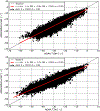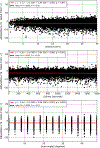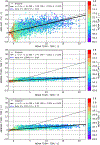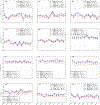Intercomparison of Surface Temperatures from AIRS, MERRA, and MERRA-2, with NOAA and GC-Net Weather Stations at Summit, Greenland
- PMID: 33414693
- PMCID: PMC7787081
- DOI: 10.1175/jamc-d-17-0216.1
Intercomparison of Surface Temperatures from AIRS, MERRA, and MERRA-2, with NOAA and GC-Net Weather Stations at Summit, Greenland
Abstract
The surface skin and air temperatures reported by the Atmospheric Infrared Sounder/Advanced Microwave Sounding Unit-A (AIRS/AMSU-A), the Modern-Era Retrospective analysis for Research and Applications (MERRA), and MERRA-2 at Summit, Greenland are compared with near surface air temperatures measured at National Oceanic and Atmospheric Administration (NOAA) and Greenland Climate Network (GC-Net) weather stations. The AIRS/AMSU-A Surface Skin Temperature (TS) is best correlated with the NOAA 2 m air temperature (T2M) but tends to be colder than the station measurements. The difference may be the result of the frequent near surface temperature inversions in the region. The AIRS/AMSU-A Surface Air Temperature (SAT) is also correlated with the NOAA T2M but has a warm bias during the cold season and a larger standard error than the surface temperature. The extrapolation of the temperature profile to calculate the AIRS SAT may not be valid for the strongest inversions. The GC-Net temperature sensors are not held at fixed heights throughout the year; however, they are typically closer to the surface than the NOAA station sensors. Comparing the lapse rates at the 2 stations shows that it is larger closer to the surface. The difference between the AIRS/AMSU-A SAT and TS is sensitive to near surface inversions and tends to measure stronger inversions than both stations. The AIRS/AMSU-A may be sampling a thicker layer than either station. The MERRA-2 surface and near surface temperatures show improvements over MERRA but little sensitivity to near surface temperature inversions.
Figures

















References
-
- AIRS Science Team/Joao Texeira, 2013a: Airs/aqua l2 cloud-cleared infrared radiances (airs+amsu) v006 (airi2ccf). Goddard Earth Sciences Data and Information Services Center (GES DISC), accessed from the Goddard Earth Sciences Data and Information Services Center (GES DISC) on 4/29/2016, doi:10.5067/AQUA/AIRS/DATA204. - DOI
-
- AIRS Science Team/Joao Texeira, 2013b: Airs/aqua l2 standard physical retrieval (airs+amsu) v006 (airx2ret). Goddard Earth Sciences Data and Information Services Center (GES DISC), accessed from the Goddard Earth Sciences Data and Information Services Center (GES DISC) on 4/29/2016, doi:10.5067/AQUA/AIRS/DATA201. - DOI
-
- Aumann HH, and Coauthors, 2003: AIRS/AMSU/HSB on the aqua mission: design, science objectives, data products, and processing systems. IEEE Transactions on Geoscience and Remote Sensing, 41, 253–264, doi:10.1109/TGRS.2002.808356. - DOI
-
- Bindschadler RA, and Coauthors, 2013: Ice-sheet model sensitivities to environmental forcing and their use in projecting future sea level (the SeaRISE project). Journal of Glaciology, 59, 195–224, doi:10.3189/2013JoG12J125. - DOI
Grants and funding
LinkOut - more resources
Full Text Sources
Research Materials
Miscellaneous
